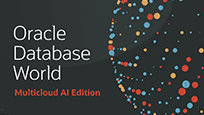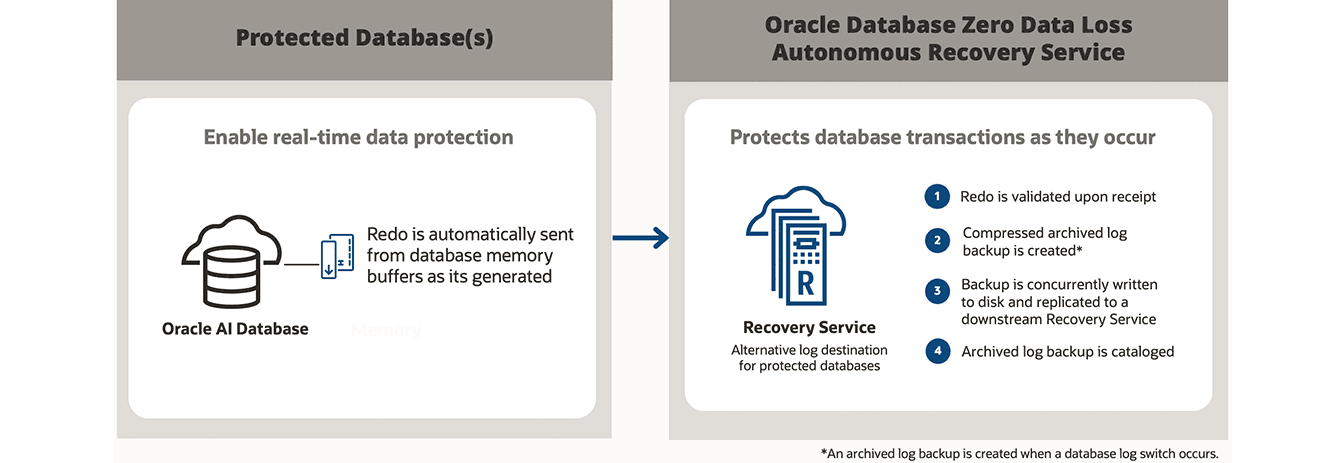Zero Data Loss Autonomous Recovery Service
Oracle Database Zero Data Loss Autonomous Recovery Service is a fully managed data protection service for Oracle databases running on OCI, Amazon AWS, Microsoft Azure, and Google Cloud. Unique, automated capabilities protect Oracle Database changes in real time, validate backups without production database overhead, and enable fast, predictable recovery to any point in time. Low costs based on the amount of data being protected mean that zero data loss resiliency is available to organizations of any size and virtually any budget.
 Oracle DatabaseWorld: Multicloud AI Edition
Oracle DatabaseWorld: Multicloud AI Edition
Advance your AI and multicloud strategies with Oracle’s latest innovations in database and cloud technologies. Watch the on-demand sessions to learn more.
-
Ransomware resiliency
Zero data loss database protection enables you to recover protected databases to within less than a second of when an outage or ransomware attack occurred.
-
Real-time transaction protection
Continuous data protection and database-aware recovery validation enable you to reliably meet data protection goals and recover to any point in time.
-
Management and operational efficiency
Automatic database protection and lifecycle management minimize administration time, improve the efficiency of production database services, and help consistently secure critical information.
Why choose Zero Data Loss Autonomous Recovery Service?
Co-developed with Oracle AI Database, Recovery Service is purpose-built to deliver exceptional zero data loss protection and cyber resiliency with fast, reliable recovery your business can count on.

This image entitled “Intelligent Oracle Database protection and cyber-resiliency in public clouds” is an overview of Recovery Service capabilities including:
- Supported Oracle AI Database services in Oracle’s public cloud (OCI) and in multicloud with Oracle Database@AWS, Oracle Database@Azure, and Oracle Database@Google Cloud.
- Core features and differentiators of real-time data protection, incremental forever backups and restore of virtual full backups.
- Recovery Service automatically replicates backups to another Recovery Service within the same region for high availability—each Recovery Service independently validates backups. Optionally, customers can make on-demand full backup copies on Recovery Service for long-term retention and storage on low-cost OCI infrequent access object storage.
Recovery Service builds on Oracle Data Guard’s redo transport and Oracle Recovery Manager (RMAN) technologies to provide continuous data protection and recovery validation. The same software that created the backup is used to validate its integrity—without overhead on database servers.
Zero Data Loss Autonomous Recovery Service use cases
-
Minimize the impact of cyberattacks
Continually protect your Oracle databases by using real-time data protection on Recovery Service and mitigate the impact of cyberattacks with rapid database recoveries to any point in time.
-
Reduce data loss exposure
Automatically protect database transactions as they occur, reducing the recovery point objective to less than one second from 15 minutes to several hours. Fully recover the backup to the point immediately before a cyberattack or other issue compromising your production database.
-
Centrally manage data protection
Consolidate data protection for all databases running on Exadata Database Service, Autonomous Database—Dedicated, Base Database Service, Oracle Database@AWS, Oracle Database@Azure, and Oracle Database@Google Cloud within your OCI compartment or customer tenancy.
-
Lower CPU consumption on database services
Use fewer CPU resources on production database services for backup and recovery processes by offloading database backup validation and other processes to Recovery Service.
-
Protect on-premises databases
Leverage Zero Data Loss Cloud Protect to enhance data protection for on-premises databases by sending backups to Recovery Service residing in any OCI region.
-
Simplify data protection management
Reduce management complexity and improve resource efficiency with minimal impact backup and recovery using an incremental forever backup strategy and restore of virtual full backups.
Operational Recovery Service highlights

This image describes real-time data protection enabled with a single click which configures Recovery Service as an alternative log destination for the protected database. As redo changes are generated in database memory, they’re automatically sent to and validated on Recovery Service as received. When a database log switch occurs, Recovery Service automatically creates a compressed archived log backup and registers it the recovery catalog.
Recovery Service preserves recoverability up to the last committed transaction even if connectivity with protected databases is interrupted in-between typical log switch occurrences. If the redo stream terminates unexpectedly, Recovery Service closes the incoming redo stream and creates a partial archived redo log file backup. When Recovery Service detects the redo stream has restarted, all missing archive redo log files are automatically retrieved from the protected database, thereby keeping your recovery window intact.
Recovery validation throughout the backup lifecycle
Enhance your resilience posture with validation extending well beyond backup integrity checks to what’s needed for successful point-in-time database recovery.

This image entitled “Continuous Database-Aware Anomaly Detection and Recovery Validation” describes how Oracle Database Zero Data Loss Autonomous Recovery Service delivers unique recovery readiness:
- Incoming redo and RMAN backup streams validated prior to storing on disk. Corrupted data, not readable by RMAN, is rejected
- Periodic validation of backups at rest and that all database transactions (SCNs) needed for RMAN point-in-time-recovery are available
- Outgoing restores, backup copies and replicated backups are validated prior to sending over the network
Autonomous Recovery Service delivers unique recovery readiness capabilities with multi-factor, database recovery-aware validation at every touch point, which includes periodic recovery validation for backups at rest—automatically and without overhead on production database servers.
Policy-based access controls and backup immutability
Safeguard backups using a defense-in-depth foundation with separation of production and data protection infrastructure, role-based separation of duties, and retention lock policies for backup immutability.

This image entitled, “Multi-layered Guardrails Protect Backup Integrity and Access”, describes key security best practices built into Recovery Service including:
- Recovery Service is designed to be fault-isolated from the production databases it protects. It operates within an Oracle-managed tenancy, utilizing private endpoint connectivity to the customer's tenancy.
- All backups must be encrypted, and customers may enable retention-lock in a Recovery Service protection policy to make the backup immutable; deletion or shortening the retention period is prohibited.
- Separation of duty access controls between Database Administrators (DBAs) and Recovery Service Administrators
Backups managed by Recovery Service cannot be arbitrarily modified or deleted by any administrator or user, thereby guarding against both malicious and accidental deletion. Database administrators (DBAs) interact with Recovery Service exclusively through Recovery Manager (RMAN), which orchestrates all backup and restore operations. Logically and physically separated from the customer tenancy, another layer of security depth is added; if DBA or systems administrator credentials were compromised, they couldn’t be used to attack backups residing on the service.
Built-in retention defaults and user-defined policies help you consistently meet service level agreements and compliance requirements for backup retention, including a 14-day minimum recovery window safeguarding retention from human error or malicious bad actors. If a protected database is terminated (deleted), Recovery Service automatically retains its backups for a minimum of 72 hours providing a safety net for accidental database deletion scenarios.
All protected databases are associated with a protection policy defining how the backup is managed throughout its lifecycle, including replication, retention (point-in-time recovery window), and retention lock settings for backup immutability.
Oracle Database Zero Data Loss Cloud Protect: Real-time protection for your on-premises Oracle databases
Kelly Smith, Senior Principal Product Manager, OracleProtect on-premises Oracle databases using Oracle Zero Data Loss Autonomous Recovery Service deployed in any OCI region. This new feature provides real-time transaction protection, logically air-gapped immutable backups, and enables fast, point-in-time recovery to any location.
Read the complete postFeatured blogs
- OCTOBER 14, 2025 Zero Data Loss Autonomous Recovery Service Is Now Available for Oracle Database@AWS
- July 7, 2025Oracle Key Vault 21.11 Adds Key Management for Exadata Database Service and Secrets Management for Oracle GoldenGate
- June 23, 2025Oracle Database 23ai Recovery Manager (RMAN) New Features Part 2—Celebrating Three Decades of Data Protection and More
- May 21, 2025 Oracle Database 23ai Recovery Manager (RMAN) New Features Part 1—Celebrating Three Decades of Data Protection and More
- MARCH 12, 2025 One-Click Compliance with Long-term Retention Now Available in Autonomous Recovery Service
Recovery Service resources
-
Learn more
Get started with Oracle Database Zero Data Loss Autonomous Recovery Service
Try it for free
Get hands-on experience with Oracle’s always free services.
Get in touch
Find out how Zero Data Loss Autonomous Recovery Service can benefit your business.